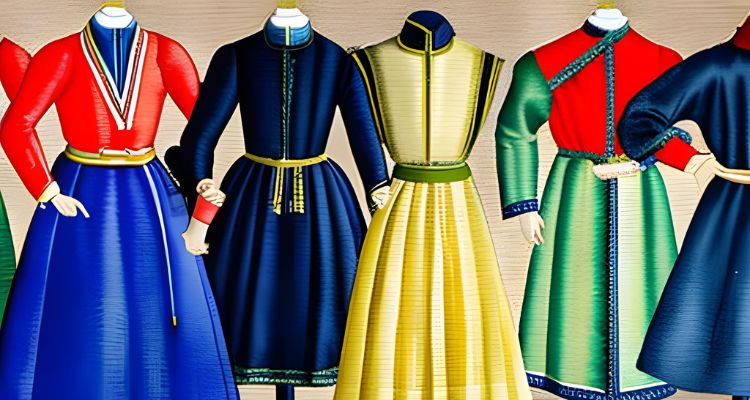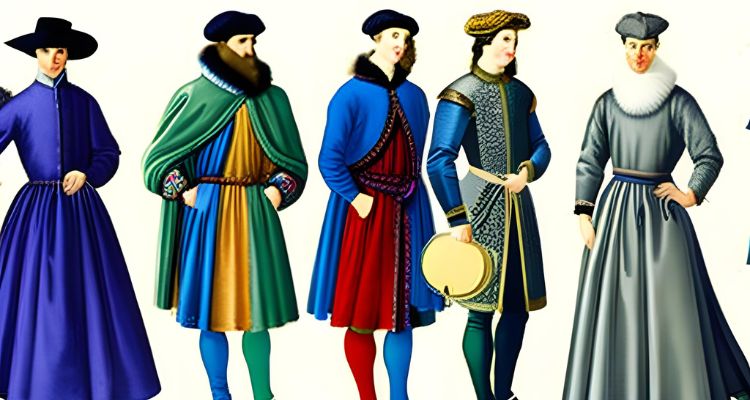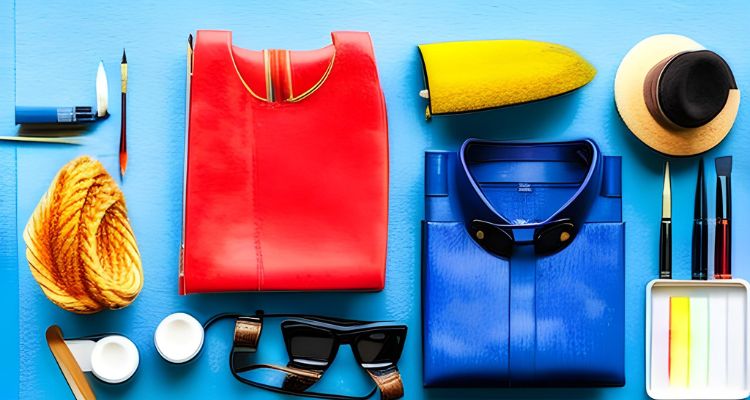Over the 15th century, Europe underwent massive alterations in numerous sectors, including the introduction of new ideas, technology, and art. These developments influenced men’s apparel throughout this period, reflecting the social, economic, and political revolutions that were taking place. It is essential to comprehend the clothing of this period not only for historical accuracy in reenactments and cosplay but also for costume design and fashion inspiration. This guide will delve into the fundamental components of 15th-century men’s clothing, specific styles and trends, accessories and embellishments, and maintenance tips for these garments. Furthermore, we will examine how 15th-century fashion continues to influence modern clothing and remains prevalent in creative fields such as film and theater. We may gain a better knowledge of the past and discover inspiration for the present and future by delving into this fascinating era of fashion history.
I. Basic elements of 15th-century men’s clothing
Men’s attire in the 15th century was created to fit the masculine physique and indicate social position and employment. Understanding the basic elements of this clothing is crucial for those interested in recreating historical fashion.
The doublet was one of the most prevalent clothing worn by males during this period. This close-fitting garment was typically made from wool or silk and worn over a shirt. It had long sleeves and a low neckline that often displayed the shirt underneath. Doublets might be simple or embellished with needlework, fur, or other materials, and they were often tied with buttons or laces.
Another essential piece of clothing was the hose. They were generally tight-fitting clothes that covered the legs and feet and were made of wool or linen. The hose could be either one piece or two, with the latter being more common among the upper classes. They were usually fastened to the doublet with laces and sometimes had padded or slashed knees for decoration.

Tunics were also worn during this time, particularly by men of lower social classes. These loose-fitting garments were made from wool or linen and were worn over the doublet and hose. They were typically shorter in length than women’s tunics and often had slits on the sides for ease of movement.
Cloaks were also worn for warmth and protection against the weather. They were often made of wool or fur and were available in a variety of lengths and designs, including sleeveless, short, and long. Cloaks were frequently lined with silk or fur and secured with a clasp or tied with a lead.
Wool was the most often used fabric for men’s clothes in terms of color and substance throughout the 15th century. Colors varied according to social status, with bright and rich hues preferred by the upper classes and subdued tones preferred by the poorer classes. Linen was also used for underwear and shirts, whilst silk was reserved for the most affluent people.
Tailoring was an important component of men’s attire in the 15th century, with clothes being made to suit the male body precisely. This necessitated the use of competent tailors who could construct garments that fit comfortably while also allowing for freedom of movement. As a result, men’s dress in the 15th century varied according to the area, social status, and employment, making it a diverse and intriguing subject to study.
II. Specific styles and trends
Men’s clothing in the 15th century varied according to social class, occupation, and region. Several styles and trends emerged around this time, reflecting altering perspectives and cultural advances.
In the early 15th century, the houppelande was a fashionable style. Over a doublet and hose, a long, loose-fitting robe was worn. Although the body of the garment might be basic or patterned, the sleeves were typically voluminous and decorated with fur or other materials. The houppelande was popular among both men and women of various social backgrounds.
Another prominent style was the cotehardie. This was a close-fitting garment worn over the doublet and hose, reaching the knee or mid-thigh. The cotehardie had long, slim sleeves that were commonly buttoned down the front. It was a popular style among the upper classes, and it was often made of rich fabrics such as silk or velvet.

In the late 15th century, men’s dresses began to shift towards a more structured look. The doublet became more appropriate with a cushioned chest and a low waistline. Sleeves grew shorter and were usually adorned with slashes to add a decorative touch. To produce a uniform appearance, the hose became shorter and was commonly sewn to the doublet.
At this period, regional variances in men’s fashion were also widespread. German fashion, for example, was distinguished by a fondness for vivid colors and extensive embellishment, whilst Italian design was more restrained and concentrated on simple, beautiful lines. The royal court had a strong impact on fashion in England, with distinct styles associated with specific rulers.
Generally, 15th-century men’s clothing patterns and trends mirrored evolving views and cultural transformations of the period. The attire of this time, from the loose-fitting houppelande to the structured doublet, gives a fascinating window into the past and continues to inspire fashion designers and historians alike.
III. Accessories and embellishments
Accessories and embellishments played a significant role in 15th-century men’s clothing, adding both practical and decorative elements to their attire. These accessories reflected social status, occupation, and personal style.
One of the most popular accessories of the time was the hat. Men wore a variety of different styles of hats, including the beret, the hood, and the chaperone. The chaperone was a hooded cape that could be worn in a variety of different styles, including draped over the head, tied under the chin, or hanging down the back. The style of hat worn often reflected an individual’s social class or occupation, with more elaborate hats being worn by those of higher status.


Belts were another common accessory, used to hold up the hose or to cinch in the waist of the doublet. Belts were often made from leather and could be plain or decorated with metal studs, embossing, or engravings. They could also be used to hold small tools or weapons, reflecting the practical nature of men’s clothing during this time.
Embellishments such as embroidery, fur, and other trims were used to add decoration and style to men’s clothing. Embroidery was often used to create intricate patterns and designs on the cuffs and collars of the doublet, while fur trims were used to add warmth and luxury to garments. Slashing or the intentional cutting of the fabric to reveal a contrasting layer underneath was also a popular decorative technique during this time.
Men wore jewelry throughout this period, with rings and brooches being the most prevalent. These products were frequently made of gold or silver and were typically embellished with expensive stones or elaborate motifs. Jewelry was typically worn by persons of greater social position to demonstrate their riches and authority.
Overall, decorations and embellishments were a significant part of 15th-century men’s clothes, contributing elegance as well as utility. These goods indicated a person’s social standing, vocation, and personal flair, making them an important aspect of historical fashion.
IV. Maintaining and caring for 15th-century men’s clothing
It was critical to maintain and care for 15th-century men’s clothes to ensure their durability and historical relevance. Clothes during this period were frequently constructed from costly and fragile fabrics such as silk, velvet, and fur, necessitating careful handling and preservation.



Proper washing was one of the most essential components of care for 15th-century men’s clothes. Clothes were frequently hand-washed with gentle soap and water, with delicate textiles being cleaned more carefully to avoid damage. It was critical to avoid employing abrasive or harsh chemicals that may degrade or discolor the cloth.
Clothing storage was also an important component of caring for 15th-century men’s apparel. Clothes were frequently stored in chests or cupboards, out of direct sunlight and humidity. To avoid pest damage, mothballs or other insect repellents were often utilized. To avoid discoloration and protect delicate materials, clothing was frequently wrapped in acid-free tissue paper.
Repairs and alterations were also common ways of maintaining 15th-century men’s clothing. Clothing was often made to last and could be repaired multiple times to extend its lifespan. Alterations were also made to update or refresh a garment, reflecting changing styles or personal preferences.
Overall, maintaining and caring for 15th-century men’s clothing required a delicate touch and attention to detail. Proper cleaning, storage, and repair were essential to ensure the longevity and historical significance of these garments. By taking care of these pieces, we can continue to appreciate and learn from the fashion of this fascinating period in history.
V. Modern applications
While 15th-century men’s clothing may seem outdated and impractical for modern wear, there are still some applications for these historical garments in contemporary fashion.
One modern application of 15th-century men’s clothing is in theatrical productions and historical reenactments. Actors and reenactors often wear historically accurate costumes to bring the past to life, and 15th-century men’s clothing is a popular choice for productions set during this period.
Another modern application of 15th-century men’s clothing is in the fashion industry. Designers may draw inspiration from historical styles and incorporate elements of 15th-century men’s clothing into their contemporary collections. For example, a designer may create a modern suit with a doublet silhouette or incorporate embroidered details inspired by historical designs.
Also, some people may opt to dress in historical attire for important occasions such as weddings or other ceremonial gatherings. Sporting historically inspired clothing may be a unique and memorable approach to separate out from the crowd and show off one’s distinctive flair.
Overall, while 15th-century men’s clothing may not be practical for everyday wear, there are still modern applications for these historical garments in theater, fashion, and special events. These applications serve to keep the fashion of the past alive and inspire new creative interpretations of historical styles.
VI. Conclusion
Finally, 15th-century men’s attire was an intriguing and diverse component of historical fashion. These clothes were an essential representation of social rank, employment, and personal style, from the fundamental parts of clothing to specialized designs and trends, accessories, and decorations.
Preserving and caring for 15th-century men’s clothes demanded a delicate touch and attention to detail, but it was necessary to maintain the garments’ lifespan and historical relevance. Nowadays, historical attire is still used in theatre, fashion, and special occasions, illustrating the ongoing attraction of these classic forms.
We may obtain a better grasp of the historical and cultural circumstances in which these clothes were worn by learning about and appreciating prior fashion. We may also use these designs as inspiration to develop fresh and inventive interpretations of historical fashion in our present environment.

